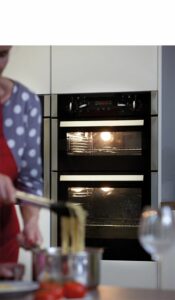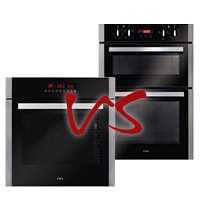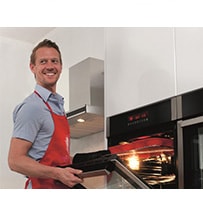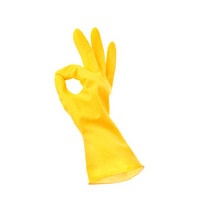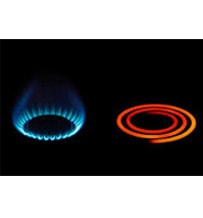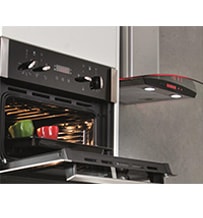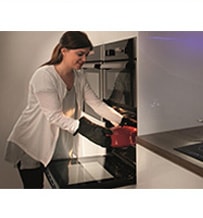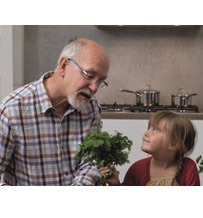
Oven Buying Guide – Oven Capacity: What Size Oven Do I Need?
If you’re looking to buy a new built-in oven, one of the first things you will need to decide is whether you want a single or double oven. If you plump for a single oven, you will also need to decide what size or capacity you will need for that single built-in oven.
In this buying guide, we’ll look at different built-in oven sizes, including the capacity of double ovens and single ovens and how to decide which internal capacity you need for your new oven.
If you limit yourself to a small, compact oven, you won’t just struggle to fit all your trimmings in for your Sunday roast – it might be a fight to get your juicy joint of meat in there at all.
Similarly, if you’re a generous host who loves to throw lavish dinner parties, you’ll need a large oven capacity. Not only to juggle a variety of different dishes to tempt your guests with but also so you don’t have to worry about limiting your guest list too.
A standard single oven cavity should be large enough to prepare simple meals for your family. But if you like to experiment, cooking big or complex menus, it’s best to go for a large capacity main cavity or double oven instead.
Large capacity ovens are a great choice for anyone who often has to cook for the whole family at once. They give you plenty more cooking space for multiple baking trays or massive casserole dishes. With one large cavity, you can cook all these dishes at the same temperature without having to heat a second cavity.
One thing that may limit your single oven search is if you’re looking for a self-cleaning pyrolytic model. Pyrolytic ovens are usually only available with standard cavity sizes. Of course, what you lose in extra space you will more than make up for in function when scrubbing burnt-on cooking residue and using harsh oven cleaning chemicals become a distant memory.
In this buying guide, we’ll look at different built-in oven sizes, including the capacity of double ovens and single ovens and how to decide which internal capacity you need for your new oven.
How much cooking space do you need?
The capacity of your built-in oven is important because it completely dictates what you can cook.If you limit yourself to a small, compact oven, you won’t just struggle to fit all your trimmings in for your Sunday roast – it might be a fight to get your juicy joint of meat in there at all.
Similarly, if you’re a generous host who loves to throw lavish dinner parties, you’ll need a large oven capacity. Not only to juggle a variety of different dishes to tempt your guests with but also so you don’t have to worry about limiting your guest list too.
A standard single oven cavity should be large enough to prepare simple meals for your family. But if you like to experiment, cooking big or complex menus, it’s best to go for a large capacity main cavity or double oven instead.
Large capacity ovens are a great choice for anyone who often has to cook for the whole family at once. They give you plenty more cooking space for multiple baking trays or massive casserole dishes. With one large cavity, you can cook all these dishes at the same temperature without having to heat a second cavity.
One thing that may limit your single oven search is if you’re looking for a self-cleaning pyrolytic model. Pyrolytic ovens are usually only available with standard cavity sizes. Of course, what you lose in extra space you will more than make up for in function when scrubbing burnt-on cooking residue and using harsh oven cleaning chemicals become a distant memory.
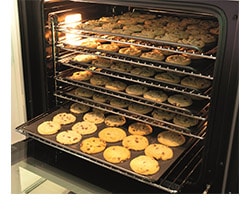
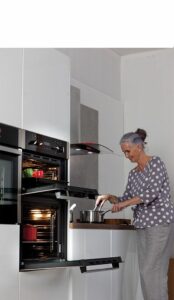
Does a double oven mean double capacity?
Buying a double oven does not always mean getting double capacity.A double oven gives you two separate cavities that you can fill with food. However, in most cases, the top cavity will be smaller than the main cavity (or vice versa). This is actually a way of optimising the energy rating and efficiency of your oven so you don’t have heat space you won’t use.
Instead, built-in or built-under double ovens usually offer one conventional oven cavity and one compact oven. This means you can bake a dessert, grill your starter or gently warm your plates while using the main oven to cook your main meal.
It is possible to get a true ‘double oven’ where the second oven cavity has the same dimensions as the first. Just pay attention to the dimensions and don’t assume they will both be equal.
If you’re still asking yourself ‘are double ovens big enough?’ There is another trick you can try to really maximise your available oven space. Instead of one built-under double oven, try installing two separate single ovens side by side instead. Create a cohesive look with a large hob across the top and it will look like one seamless cooking unit. This way ensures that you get double the space with all the multi-function cooking options that you need.
What is the capacity of an average sized oven?
The average capacity of a single oven is around 60 Litres. This will offer enough space for home cooks who only create one or two dishes at a time.If you go for a double oven, you will obviously have a little extra space, though the average size of this will depend on whether it’s a built-under double oven or one built-in at eye level.
A built-under double oven usually offers an extra 35L (approx.) of cooking space above the main oven. The built-in or ‘eye level’ double ovens tend to have a little more space in their top oven, simply due to the way that they are installed.
What is a good oven capacity?
Not everyone will be comfortable cooking with an ‘average-sized’ oven. If you like to cook a lot of different courses or foods at once, we recommend a large capacity oven instead.Our own range includes built-in ovens with a capacity of 76 litres which is around 30% larger than most standard ovens on the market. These built-in ovens will easily accommodate large dishes like joints of meat, or multi-course menus without having to Tetris the trays onto the shelves.
Just remember if you need to heat food at more than one temperature then it’s always a good bet to go for a double oven, especially with fan ovens. The temperature of convection gas ovens will often vary depending on how high the oven shelf is, as the hot air isn’t evenly distributed like it is in a fan oven. Still, you have a lot more control with two cavities.
Weight allowances of shelves
Of course, it’s all very well having plenty of available cooking space if your oven shelves aren’t up to supporting the weight of your food.It is always worth checking the weight allowance in a new oven as well as the main oven capacity. This is especially important if you’re a fan of heavy cast iron pans, or cooking hefty joints of meat.
Look for ovens that have been weight tested – the shelves across our range of ovens have been tested to 15kg.
How do you measure oven capacity?
Oven cavities are measured according to EU standards and the internal dimensions are calculated using a specifically designed disk.If you are measuring your oven yourself, you can measure the area by seeing how wide it is, how tall it is, then multiplying that by the depth of the oven space. This will give you a good idea of your current space if you’re looking to match it.
How many litres of oven do I need?
At the end of the day, finding the right oven is always about your personal needs. Capacity is no different.Remember that having more litres in one cavity is not always going to be necessary. If you cook more on the hob than in the oven and grill, then heating up a large main oven is unnecessary. If you like to cook lots of different dishes all at the same temperature, then you may be better off with one large multi-function oven than a double oven that uses extra energy to heat two cavities.
Any experimental cooks are probably best plumping for a built-in double oven.
Picking between a single or a double oven isn’t the only choice you need to make, when you’re looking to buy a new one. If you’re struggling to choose between an electric or gas oven, or aren’t sure whether catalytic liners or a steam oven are functions you need, take a look at our buying guides for more support.
